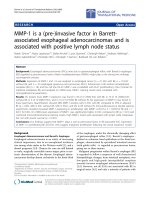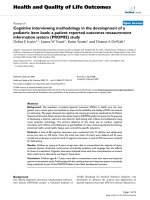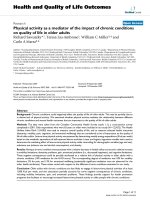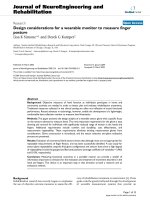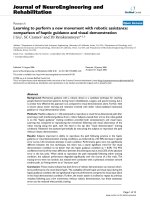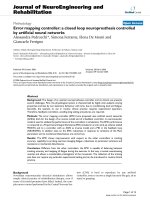Báo cáo hóa học: " Adequately assessing dehydration: A holy grail of paediatric emergency medicine" pdf
Bạn đang xem bản rút gọn của tài liệu. Xem và tải ngay bản đầy đủ của tài liệu tại đây (127.49 KB, 1 trang )
LE T T E R TO THE EDITORS Open Access
Adequately assessing dehydration: A holy grail of
paediatric emergency medicine
Damian Roland
1*
, Colin Clarke
2
, Meredith Borland
3,5
and Elaine Pascoe
4,5
We read the work by Pringle at al. [1] with interest. One
of the holy grails of Paediatric Emergency Medicine has
been the rapid and reliable identification of the child
with serious dehydration, and the converse, the ability
to know when to safely discharge a child with a history
of gastroenteritis. Recently there has been an external
validation of a previously derived clinical dehydration
scale by B ailey et a l. [2]. It is encouraging to see this
type of study as too often scoring sy stems are created
without further testing. However we wondered about
the generalisability of this result to routine Pediatric
Emergency Care. Specifically we noted that in that study
participating nurses undertook an additional training
programme prior to study commencement. Is t he score
still valid if used by Pediatric Emergency Care staff who
have not had this additional training? Our previous
work has shown that experience and training in assess-
ment may be vital in correctly assigning dehydration
categories in children [3]. We found significant variabi l-
ity between junior doctors’ assessments of dehydration
compared to their seniors. We concluded previous stu-
dies on dehydration scoring systems may hav e benefited
from well-trained staff and the introduction of these sys-
tems to naive health care professionals may not replicate
initial results. The Pringle et al. study, while containing
only a small number of subjects, challenges this conclu-
sion again as it appears the care setting may influence
the utility of the tool. The holy grail has yet to be found!
Author details
1
Paediatric Emergency Medicine Leicester Academic (PEMLA) Group,
Emergency Department Secretaries c/o Elizabeth Cadman-Moore, Leicester
Royal Infirmary, Leicester, LE1 5WW, UK
2
Emergency Department, Royal Perth
Hospital, Perth Western Australia
3
Princess Margaret Hospital for Children,
Perth, Western Australia
4
Division of Clinical Research and Education,
Princess Margaret Hospital for Children, Perth, Western Australia
5
School of
Paediatrics and Child Health, University of Western Australia, Perth, Western
Australia
Received: 18 October 2011 Accepted: 24 November 2011
Published: 24 November 2011
References
1. Pringle , et al: Comparing the accuracy of the three popular clinical
dehydration scales in children with diarrhea. Int J Emerg Med 2011, 4:58.
2. Bailey B, Gravel J, Goldman R, Friedman J, Parkin P: External validation of
the clinical dehydration scale for children with acute gastroenteritis.
AcadEmerg Med 2010, 17:583-588.
3. Roland D, Clarke C, Borland M, Pascoe E: Does a standardised scoring
system of clinical signs reduce variability between doctors’ assessments
of the potentially dehydrated child? J Paediatr Child Health 2010,
46(3):103-107.
doi:10.1186/1865-1380-4-71
Cite this article as: Roland et al.: Adequately assessing dehydration: A
holy grail of paediatric emergency medicine. International Journal of
Emergency Medicine 2011 4:71.
Submit your manuscript to a
journal and benefi t from:
7 Convenient online submission
7 Rigorous peer review
7 Immediate publication on acceptance
7 Open access: articles freely available online
7 High visibility within the fi eld
7 Retaining the copyright to your article
Submit your next manuscript at 7 springeropen.com
* Correspondence:
1
Paediatric Emergency Medicine Leicester Academic (PEMLA) Group,
Emergency Department Secretaries c/o Elizabeth Cadman-Moore, Leicester
Royal Infirmary, Leicester, LE1 5WW, UK
Full list of author information is available at the end of the article
Roland et al. International Journal of Emergency Medicine 2011, 4:71
/>© 2011 Roland et al; licensee Springer. This is an Open Access article distributed under the terms of the Creative Commons Attribution
License (http://cr eativeco mmons.org/licenses/by/2.0), which permits unrestricted use, distribution, and reproduction in any medium,
provided the original work is pro perly cited.


